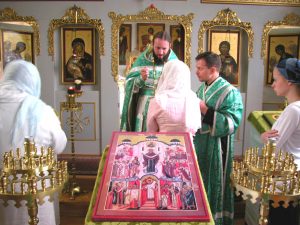Brain and religion


Last modified: 29-03-2020
The relationship between brain functioning and religious feelings was realised at the end of the nineteenth century, when it was observed that epilepsy is associated with these feelings. In recent years, a new field of knowledge has developed – Neurotheology, which tries to explore the issue.
In 1975, neurologist Norman Geschwind from Boston first described clinically a form of epilepsy, in which attacks are associated with electrical activity within the temporal lobes. Patients with temporal lobe epilepsy often talk about religious experiences during the attacks, what suggested Geschwind and neuropsychiatrist David Bearow of the Vanderbilt University that electrical discharges in certain areas of the temporal lobes can sometimes underlie obsessive religiosity. To test this hypothesis, neuroscientist Vilayanur S. Ramachandran of the University of California examined the emotional arousal (measured by changes of electrical resistance of the skin) of their patients with temporal lobe epilepsy when they listened to the words associated with religion, sex and neutral words. He showed that religious words evoke such persons unusually large emotional response, which indicates that patients with this variant of epilepsy actually may be more prone to religious experience. According to Ramachandran such sensations are the result of the strengthening of links between temporal lobes and the limbic system – the area of the brain that is responsible for emotions. Michael Persinger from the University of Ontario to confirm the temporal lobes participation in religious experience, constructed a “divine helmet,” which generated a weak electromagnetic field and focus them on selected areas of the brain, resulting in their activation. Tests on hundreds of people showed that in most of them three-minute artificial activation of the temporal lobe evokes a feeling that someone (or a spirit) is in the room, even though he/she is tested alone, or a state of deep delight. Respondents explained their experiences in accordance with their beliefs – the were talking about God, Buddha, the miracle of the universe. According to Persinger religious experience and faith are nothing more than electrical abnormalities in the human brain.
Currently, researchers do not explain religious experience only by action of the temporal lobes. Swedish researchers in 2005, tried to repeat the research of Persinger with the activation of the temporal lobes and did not get in subjects such impressions. The problem is the fact that not all religious experiences are the same. Some feel only peace while praying, others have a feeling of contact with the deity, and still others experience a mystical state, which reveals the truth unclear to normal consciousness. It is possible that different sensations are the result of activation of various brain areas. Individual differences between people can also play a role. In some religious experiences may cause the temporal lobe, while in others a different area of the brain.
Andrew Newberg and Eugene d’Aquila from the University of Pennsylvania studied in 2001, what happens in the Buddhists’ brain during meditation, when they experience a feeling of oneness with the universe. It turned out that such a state is associated with a decrease in the activity of a fragment of parietal lobe and the upregulation of the right prefrontal lobe. Similar results were obtained by Richard J. Davidson of the University of Wisconsin-Madison, who has studied hundreds of Buddhist meditators using another method. Part of the parietal lobe, which is silenced is responsible for navigation and spatial orientation and according to the researchers, this is why decrease in its activity creates a feeling of loss of physical barriers and unity with the universe. The prefrontal cortex is responsible e.g. for a focus that is needed during meditation. The researchers also noticed that people more experienced in meditation have less activation of the prefrontal cortex than in beginners. They explain that less effort it takes to entry into the trans for a person who often meditates and for a long time. Newberg and D’Aquila also examined the brains of the Franciscans in prayer. Their feeling of closeness and union with God was associated with the same areas as in Buddhist meditators.
Mario Beauregard of Montreal examined the brain activity of 15 nuns, and found six areas that are activated when nuns recall their experience of communing with God. Among these regions, he found among others this piece of parietal lobe, which underwent deactivation of Buddhists and Franciscans… This shows how complicated is Neurotheology.
Scientists do not yet know how to clearly identify areas of the brain that are activated or deactivated during religious experience, but many of them are striving for that. They are trying to find those areas because they believe that this will enable the artificial induction in humans mystical states and make them happier, healthier and more able to concentrate. Vincent Paquette, who worked with Beauregard, compares their efforts to phrenology – science from the late eighteenth and early nineteenth century, that has searched for the relationship between brain function and shape of the skull. ;Not only him is skeptical of the neurotheologies research. “You list a bunch of places in the brain as if naming something lets you understand it” – says neuropsychologist Seth Horowitz.
Neurotheologists do not claim that their study deny the existence of God. For many atheists their study may be the confirmation that God does not exist, but instead the nuns were fascinated by scans of their brains for another reason. According to them activation of certain brain areas is proof of interaction with God.
References
Biello D. (2007). Searching for the God in the Brain. Scientific American, 10 (abstract at www.sciam.com)
Author: Maja Kochanowska






Add comment